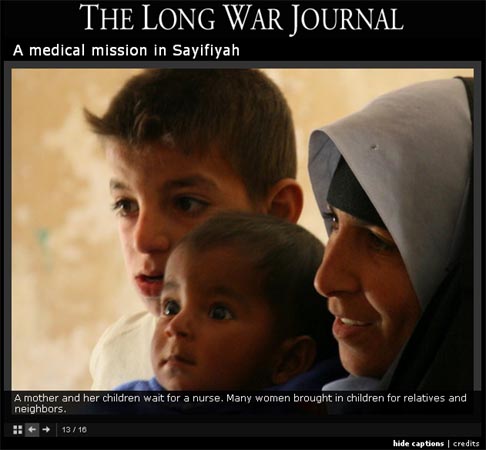On Feb. 16, the Sayafiyah Combined Medical Engagement clinic was set up in a school occupied by Apache troop of the 5th Squadron of the 7th Cavalry Regiment, 1st Brigade Combat Team, 3rd Infantry Division, the 5/7 Cav. There is currently no doctor for the towns of Sayafiyah and nearby Al Sur. The two towns combined total about 15,000 people, most of whom have not seen a doctor since al Qaeda gained control of the area.
The CME was set up as an outreach program to provide needed medical care and help establish Coalition forces as an agent of goodwill amongst the people in Sayafiyah and Al Sur. The 5/7 Cav has conducted numerous CMEs during its time in Iraq, which helped the CME in Sayafiyah to come together smoothly.
The 5/7 Cav brought in an Iraqi doctor and two Arabic-speaking nurses, as well as a number of Army medics. They examined more than 550 people, and gave all of them hygiene supplies like soap and shampoo, vitamins for the youngsters, and prescriptions as needed for actual medical problems.
There were a few people with serious medical problems — one woman with cancer, a boy with a broken leg — and quite a few elderly patients. Many of the women had three to five children with them. What makes that remarkable is that many of them were not their own children. From talking to the villagers coming through the clinic, I estimated that upwards of 50 children who came through were orphans, either in actual fact, or because their parents had fled the area and left them with neighbors.
The CME mission was a resounding success: the doctor had to shut down a few hours early because the village response had been greater than anticipated. The gate guards let in a last few patiently waiting in line, and the rest were told they would be helped in a follow-up CME as soon as more supplies came in.
Soon, there will be similar gatherings with dentists and veterinarians. Sayafiyah is a brand-new rebuilding enterprise, and 5/7 Cav is at the forefront.









3 Comments
The slideshows are a favorite feature of The Long War Journal.
In viewing photos of US soldiers, I marvel at how well equipped they are for combat.
The photos of Iraqi civilians are intriguing. Photos representing their current living conditions would also be illuminating.
Day For Optimism
A friend suggested that I needed to be more positive. In line with the recommendation, a [very heart-warming photo-essay out of Iraq](https://www.longwarjournal.org/archives/2008/02/in_pictures_the_medi.php) at [*The Long War Journal*](http://www.longwa…
Back in Vietnam where I was once an A-Team medic, we called these MED-CAPs – medical civilian action programs; of all the things I’ve ever done holding ‘sick call’ in a rural village are my favorite memories. Programs like these are the heart and soul of counter insurgency; mainly because it shows the gulf between terrorists who only see people as targets or tools, and most Americans, troops or civilians, who have a genuine empathy for the needs of others. One of the memories I have of that time is looking down the road and seeing a young boy I’d treated earlier at another village a few kilometers away, holding the hand of his blind grandfather as he brought him to us to be examined – by such acts is trust established.